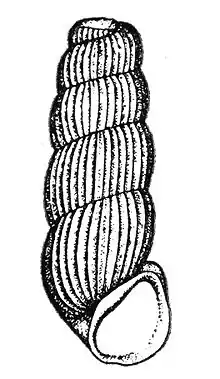截螺科
截螺科(學名:),又名斷殼蝸牛科[2][3]、斷尾蝸牛科[4]或柱螺科[5],是一種水陸兩棲的半海洋型腹足綱軟體動物的科。有鰓,但多為已退化[2]。
| 截螺科 | |
|---|---|
 | |
| Two live individuals of Truncatella subcylindrica: a juvenile on the left, and an adult on the right | |
| 科学分类 | |
| 界: | 动物界 Animalia |
| 门: | 軟體動物門 Mollusca |
| 纲: | 腹足纲 Gastropoda |
| 演化支: | 直腹足類 Orthogastropoda |
| 演化支: | 後生腹足類 Apogastropoda |
| 亚纲: | 新进腹足亚纲 Caenogastropoda |
| 目: | 玉黍螺目 Littorinimorpha |
| 总科: | 截螺總科 Truncatelloidea |
| 科: | 截螺科 Truncatellidae Gray, 1840[1] |
形態描述

Drawing of a shell of Truncatella bilabiata的外殼的繪圖
分佈
本科物種廣泛分佈分布全世界[2]。
分類
根據世界海洋物种目录及布歇特和洛克羅伊的腹足類分類 (2005年),截螺科的物種分類自1990年代以來都沒多大變化,計有兩個亞科、六個屬,分別如下[6][7][8]:
- Geomelaniinae亞科 Kobelt & Möllendorff, 1897
- Geomelania屬 L. Pfeiffer, 1845:本亞科的模式屬[8]
- Glibertiella屬 Schlickum, 1968 †
- Nystia屬 Tournouër, 1869 †
- Sandbergerina屬 Kadolsky, 1993 †
- 截螺亞科 Truncatellinae Gray, 1840
- subfamily ?
棲息地
不同種類棲息環境也不同,可棲息水域、陸地,或水陸交界處,於高潮線附近或以上的碎石地、幼細的沉質及腐殖質表面。其中截螺屬(Truncatella,又名斷殼蝸牛屬)多分布於海邊,而Geomelania 屬則完全棲息於陸地[2]。
參考文獻
- Gray (1840). Synopsis of the contents of the British Museum ed. 42: 117, 148.
- . 臺灣陸生蝸牛資訊網. [2017-06-17] (中文(繁體)).
- 張昆煌. . 貝友 (中華民國貝類學會). 1996, 22: 32–33 (中文(繁體)).
- 貝類訂名小組. . 貝類學報 (中華民國貝類學會). 1980, 7: 127–129 (中文(繁體)).
- 李彥錚. . 貝友 (中華民國貝類學會). 2002, 28: 32–53 [2019-07-14] (中文(繁體)).
- WoRMS. . World Register of Marine Species. [2017-06-17].
- Vaught, K.C.; Tucker Abbott, R.; Boss, K.J. XII. 1989: 195 pp. ISBN 0-915826-22-4.
- Frýda, J.; Hausdorf, B.; Ponder, W.; Valdés, Á.; Warén, A. Bouchet P.; Rocroi J.-P. , 编. . Malacologia: International Journal of Malacology (Hackenheim, Germany / Ann Arbor, USA: ConchBooks). 2005, 47 (1-2): 397 pp. ISBN 3-925919-72-4. ISSN 0076-2997.
- . Diversidad Biológica Cubana. [2011-03-23]. (原始内容存档于2012-06-26).
- Adams, Henry; Adams, Arthur. . Annals and Magazine of Natural History. 1863,. (3rd series) 11 (LXI): 19.
This article is issued from Wikipedia. The text is licensed under Creative Commons - Attribution - Sharealike. Additional terms may apply for the media files.
